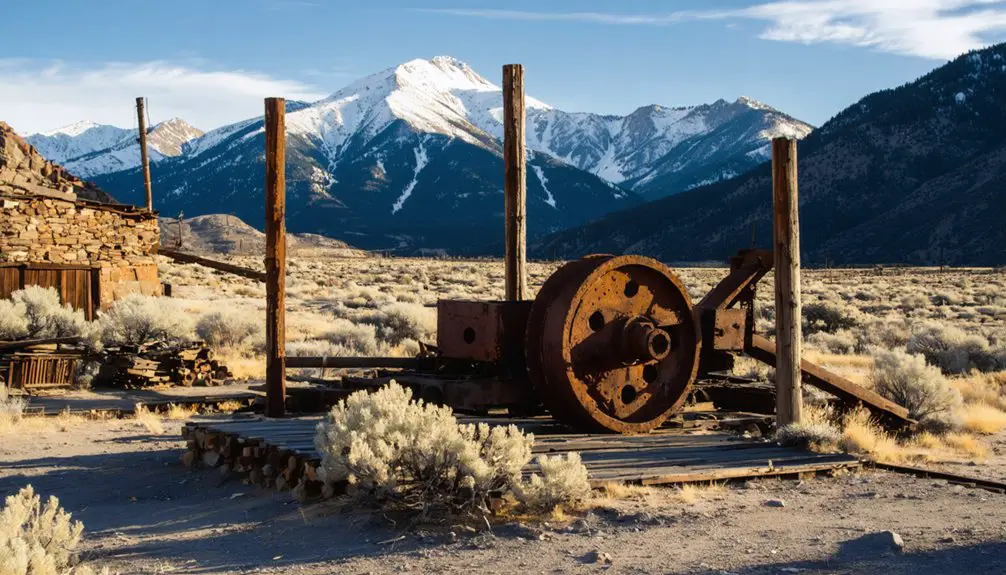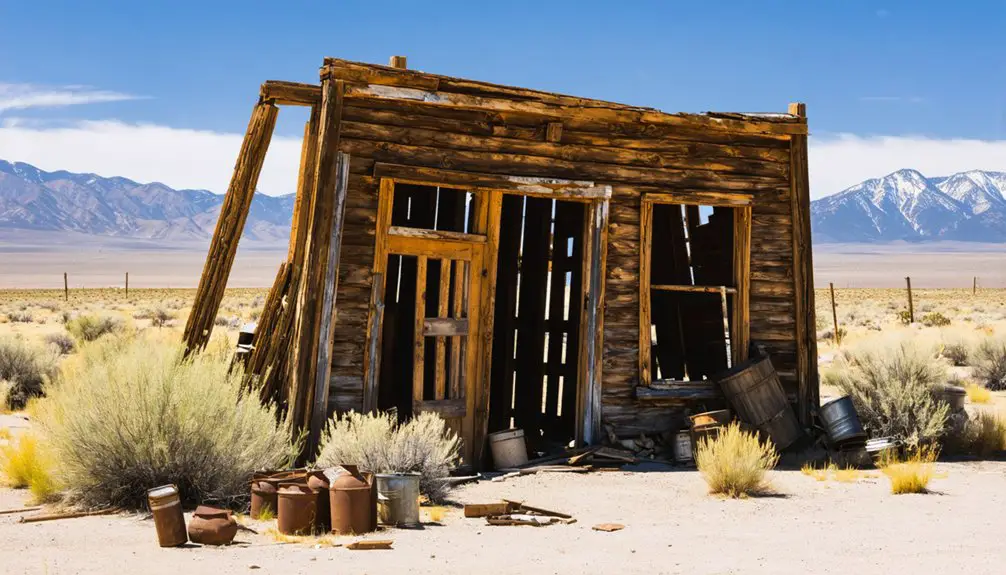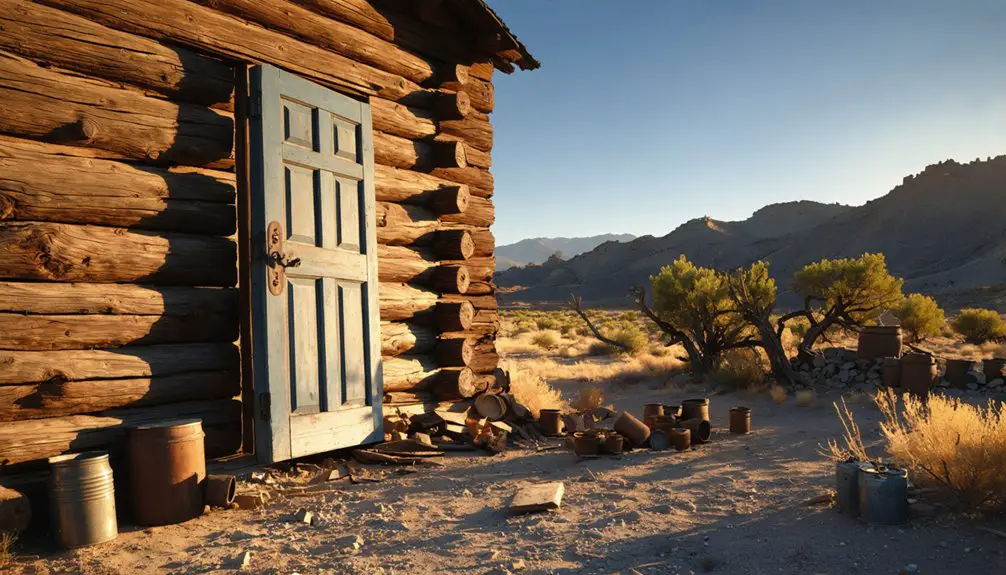You’ll find Chicken Creek’s ghost town ruins in southeastern Juab County, Utah, where Mormon pioneers first settled in 1860. The settlement thrived briefly as a strategic stop along the Mormon Road, complete with a post office and later a railroad terminus. Competition from nearby Levan’s better farming conditions and shifting transportation routes led to its decline by the 1880s. Today, stone foundations and scattered remnants tell a deeper story of pioneer perseverance and settlement challenges.
Key Takeaways
- Chicken Creek was established in 1860 along the Mormon Road in southeastern Juab County, serving as a vital transportation stop.
- The settlement declined after Levan’s establishment in 1868, which offered better farming conditions and drew settlers away.
- Utah Southern Railroad’s arrival in 1879 briefly boosted population but ultimately contributed to the town’s decline.
- The ghost town’s remains include foundation ruins and historic fireplaces that provide archaeological evidence of early pioneer life.
- Located three miles from Levan, the site demonstrates how resource competition and changing transportation routes can lead to settlement abandonment.
The First Pioneers of Chicken Creek
As winter’s grip began to loosen in March 1859, the first pioneers of Chicken Creek commenced a challenging seven-day journey from Lehi to establish what would become their new settlement near present-day Levan.
Upon arrival on March 17th, this small band of 12 to 14 determined settlers faced immediate pioneer challenges, finding deep snow that forced them to drive their cattle to Little Mountain for feed. The settlers’ efforts aligned with broader regional development, as railroad construction began in 1871 to serve southern farming communities.
You’ll find their settlement strategies were remarkably resourceful. They set up camps on Samuel Draney’s lot, chosen for its dry, sandy soil, and protected themselves from harsh north winds by piling sagebrush behind their wagons. The settlers constructed a nine-mile irrigation canal to ensure their farming efforts would have sufficient water.
To survive the extreme conditions, they dug shelter holes and maintained large campfires while working to cultivate land near a spring on Plain City’s west side.
Life on the Mormon Road
While the Mormon Road began as a rugged trail in 1847, it quickly evolved into an essential transportation artery connecting Salt Lake City to Southern California.
Pioneer experiences along this route tested the limits of human endurance as you’d face scorching desert heat, freezing mountain passes, and treacherous canyon crossings. The journey spanned over 1,300 miles through five states, requiring careful planning and immense determination.
You’d travel in organized companies divided into units of 10, 50, and 100, with appointed leaders managing daily operations.
Travel hardships included careful water rationing across the Mojave Desert, vigilant watches for hostile Native American encounters, and challenging navigation through places like Cajon Pass.
Whether by handcart, wagon, or foot, you’d rely on group cooperation and religious observances to maintain morale.
These disciplined companies created a support system that helped pioneers survive the demanding journey while moving critical supplies to growing Mormon settlements. The route followed in the footsteps of earlier travelers along the Old Spanish Trail, which provided a tested path through difficult terrain.
Early Ranching and Settlement Growth
You’ll find Chicken Creek Ranch‘s origins in 1860, when two pioneering Mormon families from Nephi established their homestead along an essential water source about 15 miles south of their previous home.
The strategic location beside Chicken Creek and the Mormon Road helped attract additional settlers, transforming the simple ranch into a growing community. Like other early Utah settlements, the abundance of water and grass proved crucial for sustaining livestock and enabling agricultural development. Following settlement patterns established by Church leadership, the community focused on agricultural development and community building.
Pioneer Ranch Families Arrive
In 1860, two pioneering families from Nephi, Utah established the first ranch at Chicken Creek, strategically positioning their settlement alongside a reliable water source.
You’ll find their settlement strategies were carefully planned, choosing a location that offered both water access and proximity to the Mormon Road for crucial communication and trade routes.
These pioneers faced immediate challenges, quickly constructing homes and ranch structures using local timber and stones from nearby hills.
They brought essential tools – axes, shovels, augers, hammers, and chisels – to build their settlement from scratch.
As they developed their ranching operations, they focused on livestock grazing near the creek’s watering areas.
To secure their future, they negotiated with local Native American leaders, particularly Chief Arrapene, trading livestock for land use rights and establishing peaceful coexistence.
To avoid confusion with other locations, settlers maintained detailed records specifying this was Chicken Creek, Utah in their correspondence.
Creek Valley Settlement Growth
During the early wave of Mormon colonization, pioneering ranchers established the first permanent settlements in Cache Valley near Chicken Creek in 1855.
You’ll find these settlement patterns were shaped by access to water sources and the need for defensive positioning against Native American conflicts.
The initial ranching plan involved summer grazing and winter migration, but nature tested the community’s resilience during a devastating winter in 1855. When a fierce blizzard struck, only 420 of 2,000 cattle survived the harsh migration through Wellsville Canyon.
Rancher William Garr lost both feet to frostbite during this ordeal. Despite these challenges, the settlers persevered, building homes close together for protection and establishing infrastructure.
Their determination laid the groundwork for permanent settlement growth, with roads like the State Road of 1850 connecting their community to essential trade routes. The settlers followed the typical north-south line of Mormon settlements that characterized early Utah colonization patterns. The first families made their permanent home at Maughans Fort in Wellsville by September 1856.
The Rise and Fall of the Post Office
As Chicken Creek transformed from a simple ranch site into a growing settlement in the early 1860s, the establishment of its post office in 1864 marked a significant milestone in the community’s development.
You’ll find that this post office served as more than just a mail center – it became the heart of community connection, facilitating essential communications along the Mormon Road.
The post office’s significance wouldn’t last long, though. When Levan emerged just three miles away in 1868, offering superior farming conditions, Chicken Creek’s residents began to drift away.
Why Settlers Chose This Location

The strategic location along Chicken Creek drew the first settlers to this promising site in the early 1860s, offering both essential water access and prime positioning along the Mormon Road.
Early pioneers were drawn to Chicken Creek’s vital waters and strategic placement on the Mormon Road in the 1860s.
You’ll find that settlement motivations centered on the creek’s reliable water availability for livestock and basic needs, while the area’s proximity to Nephi – about 14-17 miles north – provided vital trade connections.
Two pioneering families from Nephi recognized the location’s potential, establishing ranches that would form the settlement’s foundation. The area would eventually face challenges due to poor soil conditions, which impacted agricultural development.
Though soil conditions weren’t ideal for extensive farming, the site’s position along major travel routes made it an attractive stopping point.
The LDS Church’s involvement in settlement planning further validated the location choice, though they’d later support relocation to more agriculturally viable land in nearby Levan.
Competition With Neighboring Towns
You’ll find that Chicken Creek‘s initial success faced a direct challenge when Levan was established just three miles away in 1868, capturing the region’s prime farmland and water resources.
The competition for agricultural assets intensified as Levan’s superior farming conditions drew settlers away from Chicken Creek’s less sustainable ranching economy.
Agricultural Resources Battle
While Chicken Creek settlers initially established farms near their namesake waterway in the 1860s, they soon faced fierce competition from neighboring Levan over scarce agricultural resources.
You’ll find that Church leaders strategically selected Levan’s location upstream, where better water access and more fertile soil drew settlers away from Chicken Creek between 1868-1871.
The agricultural competition intensified as Levan Ridge became renowned for successful dry farming of wheat in the 1870s.
Resource scarcity proved decisive – while Chicken Creek struggled with limited water and mediocre soil, Levan’s farmers prospered through diversified crops, including orchards and truck farming.
They also benefited from university agricultural experiments and improved dry farming techniques.
Rail Routes Shift Focus
Initially serving as the Utah Southern Railroad terminus in 1879, Chicken Creek (later renamed Juab) emerged as a promising rail hub when Union Pacific interests extended the line southward from York to Frisco.
However, you’ll find that railroad competition quickly transformed the region’s traffic patterns. The Oregon Short Line‘s arrival by 1874 and subsequent gauge standardization created alternative routes, while the 1904 Lucin Cutoff diverted significant traffic from older rail segments.
As lines pushed further south toward Milford and Frisco’s silver mines, Juab’s role as a terminal point diminished. The town’s strategic importance faded when neighboring communities gained rail prominence through more direct standard-gauge connections.
Railroad’s Impact on Population Shift

As the Utah Southern Railroad established its terminus at Chicken Creek in 1879, the small settlement experienced a dramatic demographic transformation. The railroad expansion, driven by mining interests, brought waves of workers and entrepreneurs seeking opportunities in this strategic hub.
You’ll find that population shifts occurred in distinct phases:
- Initial boom as construction workers and rail personnel flooded the terminus
- Surge of mining-related traffic through the settlement, bringing temporary residents
- Influx of diverse immigrant laborers, including Chinese, Mexican, Italian, and Greek workers
- Gradual decline as rail lines extended southward to Frisco by 1880
The town’s destiny changed as the rail network grew beyond its borders.
As rail lines stretched past town limits, Chicken Creek’s role as a vital transportation hub slipped quietly into history.
When the tracks reached the mining districts, Chicken Creek’s importance faded, and people followed the economic opportunities southward.
What Remains Today
When you visit Chicken Creek today, you’ll find only scattered ruins marking where this once-active settlement stood.
The most prominent physical remains include old foundation stones and historic fireplace remnants, which offer subtle clues to the town’s original layout and architecture.
These archaeological traces represent typical ghost town decay, where natural elements have reclaimed most man-made structures over time.
Visible Foundation Ruins
The scattered foundation ruins of Chicken Creek ghost town provide the last physical evidence of this 1860s settlement.
Located 14 miles south of Nephi, Utah, these weathered remains offer archaeological insights into early Mormon pioneer life. While foundation preservation hasn’t been actively maintained, you’ll find concrete and stone bases that once supported homesteads and community buildings.
When you visit the site today, you’ll discover:
- Partially collapsed foundation stones marking original building locations
- Scattered ruins along the creek that sustained the early settlement
- Construction techniques revealed through remaining stone and concrete work
- Foundation outlines partially hidden by natural vegetation growth
These remnants help verify historical records of the town’s brief existence from 1860 to the early 1870s, though they continue to erode with time and weather exposure.
Historic Fireplace Remnants
Scattered among Chicken Creek‘s foundation ruins, historic fireplace remnants stand as silent witnesses to pioneer life in this 1860s settlement.
You’ll find these stone structures concentrated along the former central settlement area near Chicken Creek stream, marking where homes once stood. The fireplace construction primarily utilized local fieldstones and river rocks, with some featuring mortar or clay binding, while others showcase dry-stone techniques common to frontier buildings.
These hearths served dual purposes in historical usage, providing both heating and cooking functions for pioneer families.
While wooden chimneys have long since vanished, the durable stonework has endured decades of exposure.
Today, you’ll notice these deteriorating remnants offer valuable archaeological insights into early Utah settlement patterns and pioneer domestic life.
The Legacy of Failed Settlements

Failed settlements across Utah’s frontier tell a sobering story of communities that struggled against overwhelming environmental and economic challenges.
As you explore ghost towns like Chicken Creek, you’ll find evidence of pioneer challenges that proved insurmountable for many early settlers seeking economic resilience.
These settlements often collapsed due to:
- Harsh environmental conditions including drought, poor soil quality, and extreme weather
- Economic isolation and limited market access that restricted trade opportunities
- Population decline as younger generations migrated to urban areas
- Insufficient community support and resources to maintain essential services
Today, these abandoned towns serve as powerful reminders of frontier life’s harsh realities and the delicate balance required for settlement survival.
Their stories continue to influence our understanding of sustainable community development in challenging environments.
Historical Significance in Utah Territory
Established in 1860 along the essential Mormon Road, Chicken Creek emerged as a small but notable settlement in Utah Territory’s southeastern Juab County.
You’ll find this settlement reflected typical pioneer challenges of the era, as settlers grappled with limited water resources and poor soil conditions.
The settlement’s strategic location and establishment of a post office in 1864 demonstrate early settlement strategies for expanding communication networks in the territory.
However, you can trace Chicken Creek’s decline to the founding of nearby Levan in 1868, where better agricultural prospects drew residents away.
As Levan offered more fertile soil nearby, settlers steadily left Chicken Creek behind, leading to its eventual demise.
The community’s brief existence and eventual abandonment by 1871 illustrate the dynamic nature of frontier settlement patterns, where pioneers often had to adapt and relocate to survive in Utah’s challenging landscape.
Frequently Asked Questions
What Was the Original Native American Name for Chicken Creek?
Like footprints washed away by time, you won’t find the original Native American name for Chicken Creek in historical records. Despite its significance to Ute tribes, that indigenous name remains lost to history.
How Did Chicken Creek Get Its Unusual Name?
You won’t find clear records explaining Chicken Creek’s origins – the name predated the 1860 settlement. While the creek history gave the town its name, the actual reason remains a historical mystery.
Were There Any Notable Crimes or Lawlessness in Chicken Creek?
Though frontier towns often battled lawlessness, you won’t find any documented crime history or law enforcement incidents in Chicken Creek’s records from 1860-1876. The settlement remained remarkably peaceful throughout its existence.
What Crops Were Primarily Grown by the Settlers of Chicken Creek?
You’ll find their agricultural practices focused primarily on wheat through dry farming methods, while they likely cultivated alfalfa and hay for livestock. Their crop diversity remained limited due to poor soil conditions.
Did Any Famous Pioneers or Historical Figures Pass Through Chicken Creek?
You’d think such a spot on pioneer routes would’ve drawn famous faces, but no nationally known figures are documented at this historical landmark – just Mormon leaders like Erastus Snow and Brigham Young nearby.
References
- https://en.wikipedia.org/wiki/Chicken_Creek
- https://kids.kiddle.co/Chicken_Creek
- https://www.youtube.com/watch?v=qiAm7JlvZiw
- https://en.wikipedia.org/wiki/Juab
- https://kids.kiddle.co/Juab
- https://www.plaincityutah.gov/history/pages/history-daughters-utah-pioneers-plain-city-camp
- https://utahrails.net/utahrails/us-rr-1870-1881.php
- https://historytogo.utah.gov/walker-war/
- https://www.heraldextra.com/news/2008/apr/19/history-carnage-in-pole-canyon-avenged/
- https://ebornbooks.com/shop/non-fiction/mormon-lds/mormon-dup/a-history-of-levan-chicken-creek-camp-daughters-of-utah-pioneers/



